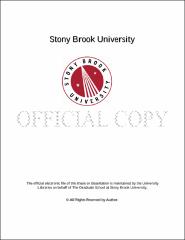| dc.identifier.uri | http://hdl.handle.net/11401/76072 | |
| dc.description.sponsorship | This work is sponsored by the Stony Brook University Graduate School in compliance with the requirements for completion of degree. | en_US |
| dc.format | Monograph | |
| dc.format.medium | Electronic Resource | en_US |
| dc.language.iso | en_US | |
| dc.publisher | The Graduate School, Stony Brook University: Stony Brook, NY. | |
| dc.type | Dissertation | |
| dcterms.abstract | There is an increasing need for precise molecular detection as a diagnostic tool for early identification of diseases, pathogens, and abnormal protein levels in the body. Typical chemical analytical methods are generally costly, unstable, and time-consuming. Molecular imprinting (MI) technique,based on the “lock and key model†, could be a simple method to overcome those shortcomings. In this study, a self-assembled monolayer (SAM) was employed as a platform to fabricate MI biosensor for detection of macromolecules. I demonstrated that, when the monolayer was formed on a rough surface, this method was in fact templating molecules in three dimensions, and hence was not limited by the height of the monolayer, but rather by the height of the roughness. This hypothesis was tested on biomolecules of multiple length scales. The SAM is assembled on the walls of the niche, forming a 3D pattern of the analyte uniquely molded to its contour. The surfaces with multi-scale roughness were prepared by evaporation of gold onto electropolished (smooth) and unpolished (rough) Si wafers, where the native roughness was found to have a normal distribution centered around 5 and 90 nm respectively. Our studies, using molecules, such as proteins, i.e., hemoglobin, ranging from a few nanometers, to viruses (i.e. polio, adenovirus), ranging from several tens of nanometers, and protein complexes ranging from several hundred nanometers, showed that when the size of the analyte matched the roughness of the gold surface, this method was very effective and could detect even small changes in the configuration, such as those induced by changes in the pH of the system. The detection method was further quantified by applying it to the detection of CEA in pancreatic cyst fluid obtained from 18 patients under IRB 95867-6. The results of the MI biosensor were directly compared with those obtained using ELISA in the hospital pathology laboratory with excellent agreement, except that the MI biosensor used only 1% of the volume of the ELISA test and produced results in less than 5 minutes, as compared to at least 10 hours. | |
| dcterms.available | 2017-09-18T23:49:58Z | |
| dcterms.contributor | Sokolov, Jonathan | en_US |
| dcterms.contributor | Rafailovich, Miriam | en_US |
| dcterms.contributor | Simon, Marcia | en_US |
| dcterms.contributor | Levon, Kalle. | en_US |
| dcterms.creator | Yu, Yingjie | |
| dcterms.dateAccepted | 2017-09-18T23:49:58Z | |
| dcterms.dateSubmitted | 2017-09-18T23:49:58Z | |
| dcterms.description | Department of Materials Science and Engineering | en_US |
| dcterms.extent | 58 pg. | en_US |
| dcterms.format | Application/PDF | en_US |
| dcterms.format | Monograph | |
| dcterms.identifier | http://hdl.handle.net/11401/76072 | |
| dcterms.issued | 2016-12-01 | |
| dcterms.language | en_US | |
| dcterms.provenance | Made available in DSpace on 2017-09-18T23:49:58Z (GMT). No. of bitstreams: 1
Yu_grad.sunysb_0771E_12815.pdf: 14006953 bytes, checksum: 13a3dc0352db3bf7cfc5436a0fa2549d (MD5)
Previous issue date: 1 | en |
| dcterms.publisher | The Graduate School, Stony Brook University: Stony Brook, NY. | |
| dcterms.subject | Materials Science | |
| dcterms.subject | biosensor, Molecular imprinting, Self-assembled monolayer | |
| dcterms.title | Fabrication of a novel biosensor for macromolecules detection through molecular imprinting technique | |
| dcterms.type | Dissertation | |

